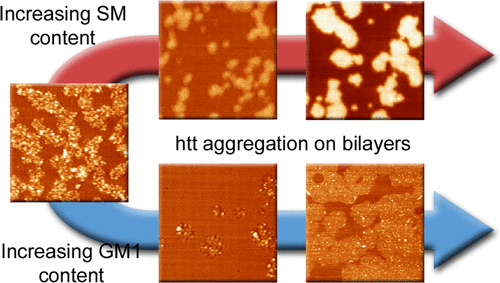Our official English website, www.x-mol.net, welcomes your
feedback! (Note: you will need to create a separate account there.)
Sphingomyelin and GM1 Influence Huntingtin Binding to, Disruption of, and Aggregation on Lipid Membranes
ACS Omega ( IF 3.7 ) Pub Date : 2018-01-10 00:00:00 , DOI: 10.1021/acsomega.7b01472 Maxmore Chaibva 1 , Xiang Gao 1 , Pranav Jain 1 , Warren A. Campbell 2 , Shelli L. Frey 2 , Justin Legleiter 1, 3
ACS Omega ( IF 3.7 ) Pub Date : 2018-01-10 00:00:00 , DOI: 10.1021/acsomega.7b01472 Maxmore Chaibva 1 , Xiang Gao 1 , Pranav Jain 1 , Warren A. Campbell 2 , Shelli L. Frey 2 , Justin Legleiter 1, 3
Affiliation

|
Huntington disease (HD) is an inherited neurodegenerative disease caused by the expansion beyond a critical threshold of a polyglutamine (polyQ) tract near the N-terminus of the huntingtin (htt) protein. Expanded polyQ promotes the formation of a variety of oligomeric and fibrillar aggregates of htt that accumulate into the hallmark proteinaceous inclusion bodies associated with HD. htt is also highly associated with numerous cellular and subcellular membranes that contain a variety of lipids. As lipid homeostasis and metabolism abnormalities are observed in HD patients, we investigated how varying both the sphingomyelin (SM) and ganglioside (GM1) contents modifies the interactions between htt and lipid membranes. SM composition is altered in HD, and GM1 has been shown to have protective effects in animal models of HD. A combination of Langmuir trough monolayer techniques, vesicle permeability and binding assays, and in situ atomic force microscopy (AFM) were used to directly monitor the interaction of a model, synthetic htt peptide and a full-length htt-exon1 recombinant protein with model membranes comprised of total brain lipid extract (TBLE) and varying amounts of exogenously added SM or GM1. The addition of either SM or GM1 decreased htt insertion into the lipid monolayers. However, TBLE vesicles with an increased SM content were more susceptible to htt-induced permeabilization, whereas GM1 had no effect on permeablization. Pure TBLE bilayers and TBLE bilayers enriched with GM1 developed regions of roughened, granular morphologies upon exposure to htt-exon1, but plateau-like domains with a smoother appearance formed in bilayers enriched with SM. Oligomeric aggregates were observed on all bilayer systems regardless of induced morphology. Collectively, these observations suggest that the lipid composition and its subsequent effects on membrane material properties strongly influence htt binding and aggregation on lipid membranes.
中文翻译:

鞘磷脂和GM1影响亨廷顿蛋白与脂膜的结合,破坏和聚集。
亨廷顿病(HD)是一种遗传性神经退行性疾病,由亨廷顿(htt)蛋白N端附近的聚谷氨酰胺(polyQ)道的临界阈值超出极限而引起。扩展的polyQ促进了多种htt的寡聚和原纤维聚集体的形成,这些聚集体积累到与HD相关的标志性蛋白质包涵体中。htt还与包含多种脂质的众多细胞膜和亚细胞膜高度相关。由于在HD患者中观察到脂质稳态和代谢异常,我们研究了鞘磷脂(SM)和神经节苷脂(GM1)含量的变化如何改变htt与脂质膜之间的相互作用。HD中的SM成分发生了变化,并且GM1已显示对HD动物模型具有保护作用。结合使用Langmuir槽单层技术,囊泡通透性和结合测定以及原位原子力显微镜(AFM),可以直接监测模型,合成的htt肽和全长htt-exon1重组蛋白与模型膜的相互作用由全脑脂质提取物(TBLE)和不同量的外源添加的SM或GM1组成。SM或GM1的添加减少了htt插入脂质单层的情况。然而,SM含量增加的TBLE囊泡更易受htt诱导的通透性影响,而GM1对通透性没有影响。暴露于htt-exon1的纯TBLE双层和富含GM1的TBLE双层会形成粗糙的颗粒状形态区域,但在富含SM的双层中形成具有更平滑外观的高原样结构域。不论诱导的形态如何,在所有双层系统上均观察到寡聚体。总的来说,这些观察结果表明脂质组成及其对膜材料性质的后续影响强烈影响HTT在脂质膜上的结合和聚集。
更新日期:2018-01-10
中文翻译:

鞘磷脂和GM1影响亨廷顿蛋白与脂膜的结合,破坏和聚集。
亨廷顿病(HD)是一种遗传性神经退行性疾病,由亨廷顿(htt)蛋白N端附近的聚谷氨酰胺(polyQ)道的临界阈值超出极限而引起。扩展的polyQ促进了多种htt的寡聚和原纤维聚集体的形成,这些聚集体积累到与HD相关的标志性蛋白质包涵体中。htt还与包含多种脂质的众多细胞膜和亚细胞膜高度相关。由于在HD患者中观察到脂质稳态和代谢异常,我们研究了鞘磷脂(SM)和神经节苷脂(GM1)含量的变化如何改变htt与脂质膜之间的相互作用。HD中的SM成分发生了变化,并且GM1已显示对HD动物模型具有保护作用。结合使用Langmuir槽单层技术,囊泡通透性和结合测定以及原位原子力显微镜(AFM),可以直接监测模型,合成的htt肽和全长htt-exon1重组蛋白与模型膜的相互作用由全脑脂质提取物(TBLE)和不同量的外源添加的SM或GM1组成。SM或GM1的添加减少了htt插入脂质单层的情况。然而,SM含量增加的TBLE囊泡更易受htt诱导的通透性影响,而GM1对通透性没有影响。暴露于htt-exon1的纯TBLE双层和富含GM1的TBLE双层会形成粗糙的颗粒状形态区域,但在富含SM的双层中形成具有更平滑外观的高原样结构域。不论诱导的形态如何,在所有双层系统上均观察到寡聚体。总的来说,这些观察结果表明脂质组成及其对膜材料性质的后续影响强烈影响HTT在脂质膜上的结合和聚集。











































 京公网安备 11010802027423号
京公网安备 11010802027423号